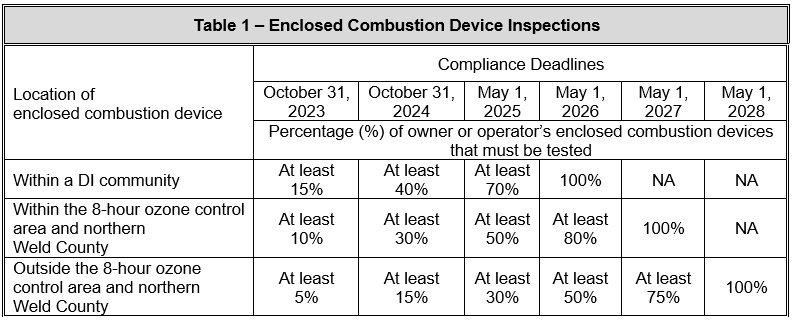In December 2021, the Colorado Air Quality Control Commission adopted a broad range of new regulations aimed at reducing emissions of greenhouse gas pollutants and ozone precursors, with emission reductions prioritized in disproportionately impacted communities (DIC). The regulations adopted covered several broad topic areas and spanned both Regulation 7 and Regulation 22.
This post is dedicated to the revisions adopted for Regulation 7 that affect both Upstream and Midstream Operations:
- The latest full version of Regulation 7 can be found at the following link.
- A redline version of Regulation 7, showing all changes adopted in December 2021, can be found at the following link.
Air pollution control equipment inspections, performance testing, and flow metering (I.E., I.J., II.B.)
Revisions applicable to certain devices in the NAA (I.E. & I.J.)
Conduct periodic performance testing on combustion control devices that control:
- Each storage vessel that has the potential for volatile organic compound (“VOC”) emissions ≥ 6 tpy (controlled actuals)
- VOC emissions from wet seal fluid degassing systems on wet seal centrifugal compressors
Initial test must be conducted by 5/1/2023 and subsequent performance tests no longer than 60 months following the previous performance test. Tests must be conducted in accordance with 40 CFR Part 60, Subpart OOOOa, Section 60.5413a(b) (June 3, 2016).
Control device models tested in accordance with 40 CFR Part 60, Subpart OOOOa, Section 60.5413a(d) and demonstrating continuous compliance in accordance with 40 CFR Part 60, Subpart OOOOa, Section 60.5413a(e)(1) (June 3, 2016) are not subject to the performance test requirement.
Revisions applicable to air pollution control equipment statewide (II.B.)
Weekly inspections of air pollution control equipment (II.B.2.f.)
Operators must conduct weekly inspections of air pollution control equipment, with detailed inspection requirements listed in II.B.2.f.(ii).
- Requirement already existed for air pollution equipment used to control storage tanks subject to II.C.1. and was relocated from section II.C. to section II.B.
- For all other air pollution control equipment that began operation prior to 2/14/2022, first inspection must occur by 5/1/2022.
- For air pollution control equipment constructed after 2/14/2022, first inspection must occur within 30 days of commencement of operation.
Installation and operation of flow meters at the inlet to enclosed combustion devices (II.B.2.g.)
Operators must install and operate flow meters at the inlet to enclosed combustion devices (“ECDs”):
- By 12/31/2022 for ECDs located in DICs that commenced operation prior to 2/14/2022
- By 5/1/2023 for all other ECDs that commenced operation prior to 2/14/2022
- By commencement of operation for ECDs that commence operation on or after 2/14/2022
There are some limited exemptions to this flow meter requirement listed in II.B.2.g.(iii).
Performance testing requirement (II.B.2.h.)
Each ECD that is required to achieve at least 95% control per Regulation 7 must be performance tested according to a Division-approved testing protocol. All ECDs within a bank of ECDs must be tested during the same testing event, which may occur over multiple working days. Tested ECDs must be equipped with an inlet flow meter prior to and through the performance test, where the Division-approved protocol requires inlet flow measurements. Temporary flow meters may be used to meet this requirement.
Following a failing test, the owner or operator must repair the device within 30 days of the failing test and re-test the device within 90 days of the corrective action. Results of the failing test must be used to calculate actual emissions for the calendar year of the failing test up to the passing retest.
Initial test schedule and notification (II.B.2.h.(ii-iii))
- For ECDs that commenced operation before 12/31/2021, initial test must be conducted according to the Regulation 7 Table 1 schedule. A performance test conducted in accordance with Division-approved testing protocols between 1/1/2020 and 10/31/2023 will satisfy the initial performance testing requirements in Section II.B.2.h(ii)(A).
- For ECDs that commenced operation on or after 12/31/2021, initial test must be conducted within two (2) years after commencement of operation (except newly manufactured devices tested by their manufacturer per NSPS OOOOa, which must be tested within five [5] years after commencement of operation).
- By 7/31/2022, notification must be submitted to the Division including a list of all ECDs that commenced operation prior to 12/31/2021 and when they will be tested to meet the Regulation 7 Table 1 schedule.



